6. Continuous and Discontinuous Differentials and Derivatives of Judgements of Dialectical Logic
L. G. Kreidik (translation from Russian T. S. Kortneva and G. P. Shpenkov)
6.1. Material and ideal points
Adequate descriptions of objective-subjective processes are based on the concept of material and ideal points:
An ideal point xi is the limit of the sequences of enclosed volumes of material points, when the largest cross-section of the volumes tends to zero. The position of an ideal point is defined by its mathematical coordinates. In particular, if a point is on the x-axis then its coordinate and the point itself will be denoted by the same symbol xc.
A material point xm is any object with a
very small volume, the size of which must not be neglected. A material point
position and size will be defined by an arbitrary ideal point. In particular,
if the material point is on the .x-axis, its position and size will have the
form of the interval ![]() ,
where xc is some ideal point of the material point xm.
Thus, in the case of the linear material point, we have
,
where xc is some ideal point of the material point xm.
Thus, in the case of the linear material point, we have
![]() . (1.106)
. (1.106)
Material points will be denoted for short by the same symbol xc as ideal points.
6.2 Additive differentials
Mutual additive parameters of the points and relations within material points will be expressed by additive differentials. There are four main types of the additive differentials:
 .
(1.107)
.
(1.107)
The first differential, MS, describes finite variations, the second, D S, describes minor variations, the third, m S, describes minute variations, the fourth dS describes variable variations, assuming any infinitesimal values, including zero at the corresponding point of a judgement. Of course, such partition of differentials on the four types has relative character.
Additive variations (differentials) will be supplemented by inverse additive variations-differentials at an arbitrary point t:
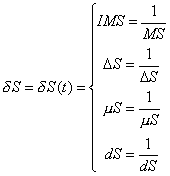 (1.108)
(1.108)
and at a definite point ![]() :
:
![]() ,
(1.109)
,
(1.109)
where ![]() is some characteristic ideal point of the material point
is some characteristic ideal point of the material point ![]() .
.
6.3. A dditive derivatives
The generalized additive derivative is defined by the expression
![]() ,
(1.110)
,
(1.110)
where dS and dt are differentials of any types
and ![]() is
the inverse differential.
is
the inverse differential.
If the differentials are continuous, the limit of the relation
![]() (1.111)
(1.111)
defines a continuous derivative. Differentials of the same type form average derivatives and differentials of different types define derivatives of different degrees of discreteness:
![]() ,
,
![]() ,
, ![]() ,
,
![]() ,
, ![]() ,
,
![]() , (1.112)
, (1.112)
where dt is some small increment of the argument t. These derivatives will be called discontinuous, discrete, indiscrete, etc.
Material and ideal points, at which a judgement has a continuous derivative, are points of continuous change or continuous transition. Material points with discontinuous derivatives define points of discontinuous change or transition. Discontinuous derivatives will be expressed in the form:
![]() ,
(1.113)
,
(1.113)
where dt is the change in the t variable within
the material point of the discontinuous transition of the judgement and ![]() is
the inverse differential. Contraction of the material point to an ideal one
results in an ideal discontinuous derivative.
is
the inverse differential. Contraction of the material point to an ideal one
results in an ideal discontinuous derivative.
6.4. Derivatives and character of variation of judgements
As oppositi-judgements, derivatives allow us to express judgements about the behavior of the judgement, which visually can be expressed by a plot of the oppositus and its derivative.
We are interested primarily in the points, at which judgements experience breaks and sudden change, expressing continuous-discontinuous transitions in nature. Let at the material point xm a judgement-oppositus undergoes discontinuous transition on the qualitative side and continuous transition on the quantitative side. Graphically it is expressed by a break (Fig. 1.8). A judgement with a break is described by the logical structure
![]() ,
(1.114)
,
(1.114)
where ![]() and
and
![]() are oppositi
that determine the behavior of the judgement
are oppositi
that determine the behavior of the judgement ![]() before and after the transition;
before and after the transition; ![]() and
and![]() - are unit step-judgements:
- are unit step-judgements:

 , (1.115)
, (1.115)
where ![]() and
and ![]() are functions
at the point.
are functions
at the point.
The step-judgements describe sharp transitions from 0 to 1 and from 1 to 0 within the material point.
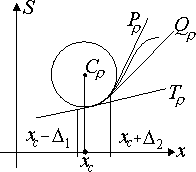
Fig. 1.8. The oppositus and its derivatives at the domain of break.
These transitions will be called discontinuous, discrete, or indiscrete, depending on the degree of their steepness. These are real contradictory transitions, discreteness of which is realized through continuity.
If a material point contracts to an ideal point, step-judgements become ideal step-judgements. The behavior of function (1.114) will be expressed by the simplified model
 (1.116)
(1.116)
where ![]() is a limiting point of a material point of transition;
is a limiting point of a material point of transition; ![]() is
the range of the transition;
is
the range of the transition; ![]() are values of the judgement within the range of the transition and laying on
the arc of the circle
are values of the judgement within the range of the transition and laying on
the arc of the circle ![]() with the radius
with the radius ![]() ,
symbolizing the material point of the graph of the judgement (Fig. 1.8).
,
symbolizing the material point of the graph of the judgement (Fig. 1.8).
The values of the judgement on the left and on the right from the break point will be assumed to be equal to the value of the judgement at that very point to within variations of the judgement in limits of this point:
![]() ,
(1.117)
,
(1.117)
The values of the derivatives on the left and on the right of xc are not equal:
![]() .
(1.118)
.
(1.118)
When the radius ![]() is small, the judgement S has, at the material point xm
is small, the judgement S has, at the material point xm
a) the left derivative determining the slope of the tangent
![]() :
:
![]() ;
(1.119)
;
(1.119)
b) the right derivative determining the slope of the tangent
![]() :
:
![]() (1.120)
(1.120)
a set of intermediate derivatives along the arc S, whose
values fill continuously the interval![]() :
:
![]() (1.121)
(1.121)
and determine the set of slopes of the intermediate tangents
![]() .
.
At the material point of break, the derivative can be expressed by the functional structure
![]() ,
,
![]() , (1.122)
, (1.122)
where ![]() is a jump of the derivative.
is a jump of the derivative.
Over the whole range of the judgement change we have:
![]() ,
(1.123)
,
(1.123)
where the first and third terms determine the change of the derivative before and after the jump.
If we assume
![]() ,
(1.124)
,
(1.124)
then
![]() .
(1.125)
.
(1.125)
Here the first term is a continuous component of the derivative
outside the material point. Within the material point ![]() , the second term determines the discrete component of the derivative. Thus,
the derivative defined by (1.125) is a continuous-discontinuous derivative.
, the second term determines the discrete component of the derivative. Thus,
the derivative defined by (1.125) is a continuous-discontinuous derivative.
If the derivative ![]() does not have a break at the material point, i.e. its left and right erivatives
are equal:
does not have a break at the material point, i.e. its left and right erivatives
are equal: ![]() ,
then at the material point the second derivative becomes
,
then at the material point the second derivative becomes
![]() .
(1.126)
.
(1.126)
6.5. A generalized in verse differential
Since at the material point xm the average derivative of a unit step-judgement is equal to the inverse differential
![]() ,
where
,
where ![]() (1.127)
(1.127)
(see Fig. 1.8), it seems reasonable to introduce a generalized
inverse differential, defining it as the inverse differential-function ![]() ,
equal to the derivative of the unit step-judgement at the material point
xm :
,
equal to the derivative of the unit step-judgement at the material point
xm :
![]() (1.128)
(1.128)
Thus, we can speak about two inverse differentials: a differential-average derivative and a differential-instantaneous derivative at the material point xm. For simplicity, in what follows inverse differentials of both types will be called identically as inverse differentials. When the material point xm contracts to an ideal point xc , the inverse differential-function becomes a limiting inverse ideal differential equal to the d -function.
In terms of the inverse differential, the second derivative of a judgement at the material point will be expressed in the form
![]() .
(1.129)
.
(1.129)
The plot of the inverse differential-function shaped as a compact pulse determines completely all changes of the nth derivative at xm if any breaks of the derivatives are lacking:
![]() (1.130)
(1.130)

Fig. 1.9. The inverse differential and its two first derivatives.
Figure 1.9 shows plots of the inverse differential-function
and its two derivatives, first and second. They show the behavior of the derivatives
at the points of a pure break, described by the present simplified model of
the break, to within a constant factor ![]() .
.
6.6. A total derivative of a judgement
For ![]() ,
the family of the oppositi S with their derivatives becomes an oppositus
with an ideal absolutely sharp break (Fig. 1.10).
,
the family of the oppositi S with their derivatives becomes an oppositus
with an ideal absolutely sharp break (Fig. 1.10).
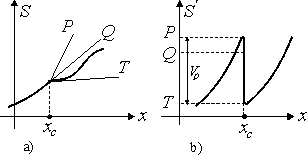
Fig. 1.10. The function S and its derivative S' in the region of an ideal break.
At the point of an ideal mathematical break, the opposite has:
a) the left derivative determining the slope of the tangent P
![]() ;
(1.131)
;
(1.131)
b) the right derivative determining the slope of the tangent T:
![]() (1.132)
(1.132)
c) a set of intermediate derivatives , whose values fill continuously
the interval ![]() :
:
![]() (1.133)
(1.133)
and determine a set of slopes of intermediate tangents Q .
If at the material point the conditions
![]() and
and ![]() , (1.134)
, (1.134)
are satisfied, the judgement undergoes discrete transition with a discrete derivative at the transition point:
![]() ,
where
,
where ![]() . (1.135)
. (1.135)
This transition will be called a jump at the material point (Fig. 1.11). In the transition, there occurs informal quantitative discontinuity and qualitative continuity.
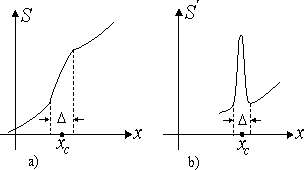
Fig. 1.11. The function S and its derivative S' in the region of a jump.
The total derivative of a judgement with a jump has the form:
![]() ,
(1.136)
,
(1.136)
where ![]() is a continuous component of the derivative;
is a continuous component of the derivative; ![]() is
a discontinuous component of its.
is
a discontinuous component of its.
Accordingly, the n-th derivative of the jump has the form
![]() .
(1.137)
.
(1.137)
A complete discrete transition (a jump with a break, Fig.1.12) is characterized by the condition:
![]() and
and ![]() . (1.138)
. (1.138)
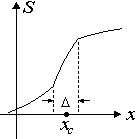
Fig. 1.12. Function S in the region of a jump with a break
In the transition the first derivative contains one continuous term and two discrete ones, determining the qualitative and quantitative discreteness:
![]() .
(1.139)
.
(1.139)
Differentiation of the first derivative gives
![]() .
(1.140)
.
(1.140)
and so on.
There are also the following types of discreteness of the judgement S:
a) a pulse (a double jump) (Fig. 1.13a)
![]() ,
,
![]() Ķ
Ķ ![]() , 1.141)
, 1.141)
b) a pulse with a break (Fig. 1.13b)
![]() ,
,
![]() and
and ![]() ,
(1.142
,
(1.142
c) a pulse with a jump (Fig. 1.13c)
![]() ,
,
![]() and
and ![]() ,
(1.143)
,
(1.143)
d) a pulse with a break and a jump (Fig. 1.13d)
![]() ,
,
![]() and
and ![]() .
(1.144)
.
(1.144)
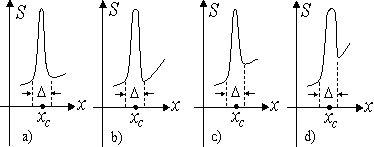
Fig. 1.13. Possible types of discreteness of a judgement S.
As the cross-section of a material point increases, discreteness spreads, becoming continuity.
Theoretical Dialectical Journal: Physics-Mathematics-Logic-Philosophy, N.1, site http://www.tedial.narod.ru/